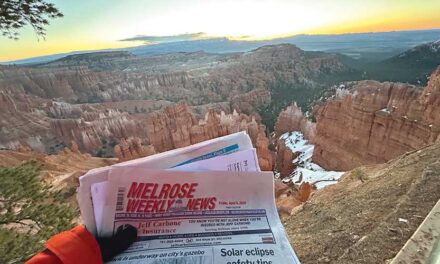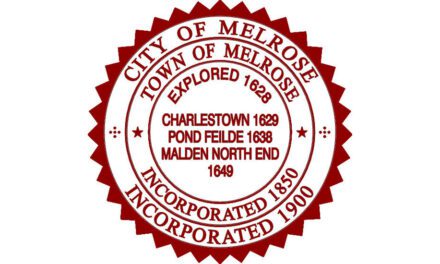Published December 11, 2020
By FINN McSWEENEY and RYAN WILLIAMS
Melrose residents are passionate about our little city. Volunteerism and community engagement abound here because so many of us share a desire to protect the Melrose of today while planning the Melrose of tomorrow.
We have collectively invested thousands of hours to give input to our city and our elected officials as we work together toward that future. We created a comprehensive Open Space Plan in 2015 and an overarching Master Plan in 2017. We have begun the work to create an affordable housing plan, design the future of Ell Pond and create a NetZero 2050 plan. These plans contain hundreds of recommendations for preserving and improving the character and quality of life that have made Melrose one of the most desirable cities in our region. In each instance, we’ve spoken loud and clear about many things we want to see in our future: protected open spaces, better parks, historic buildings restored to their former glory, and more progress toward affordable housing.
Unfortunately, without a reliable and dedicated funding source, we have struggled to achieve any of these goals. Most immediately, in the face of mounting pressure from developers, we have taken no real action to protect our few remaining open spaces in Melrose. We can watch it happening right in front of us. On Montvale Street, in the southeast corner of Melrose, is a small, sloped parcel of land which abuts two city-owned conservation properties. Last month, neighborhood residents who for decades have watched wildlife pass through these areas were distraught to learn that it had sold for just $17,500 to a developer who plans to carve up the rock and bolt an expensive house onto the rock face.
On the other side of town, off Swains Pond Avenue, residents endure multiple explosions of dynamite each day, as developers work tirelessly to blow up and cart away a 200-foot-high stone ledge, removing incomprehensible quantities of rock in order to build nine luxury homes where a mature forest once stood. Previously named the “Colucci Estates,” this property has a storied local history — a history of the city failing, for decades, to protect it from developers when they had the chance. This is just the latest McMansion subdivision in recent years to be blasted into Ward 7, a neighborhood which has precious little open space remaining.
What if we told you that, for less than $5 a month, we could collectively put millions of dollars toward protecting open space, improving our parks, funding affordable housing needs, and preserving our historic heritage? Well, it’s true — we do have this option. It’s called the Community Preservation Act, and with action taken by the City Council in conjunction with the mayor, we could vote to make it a reality in Melrose as early as next year.
The Community Preservation Act (CPA), which became Massachusetts law in 2000, gives cities and towns the means to set up a dedicated fund for preserving open space and historic sites, creating affordable housing, and developing outdoor recreational facilities. Passing the CPA is simple: All a city or town needs to do is to put it on a ballot for residents to vote on. In Melrose, that means the City Council needs to vote to put the adoption question on an election ballot. That simplicity is one of the reason why 186 of the state’s 351 municipalities (53 percent) have already passed this measure. Melrose is behind the times — and it’s costing us, dearly.
CPA money comes from both state and local sources. How does it work? Contrary to popular belief, adopting the Community Preservation Act does not mean your property tax rates will go up. Instead, it’s funded by a surcharge of as little as 1 percent of your existing property tax bill. That surcharge, which is set by voters, is much smaller than you think. If we adopted a 1 percent CPA charge, the average Melrose household would pay less than $5 a month, and low-income households (earning about $95,000 for a family of four), as well as low- and moderate-income seniors, would be exempt.
Here’s an example: Based on FY20 tax figures, the average assessed value for a home in Melrose is $634,884. Usually, under the CPA, the first $100,000 in assessed residential or commercial property value is exempted, so for our example property, we will use $534,884. Melrose’s FY20 residential tax rate was $11.05 per $1,000. This resident will pay $5,910.47 in annual property taxes. Should Melrose adopt a 1 percent CPA surcharge, this homeowner would pay an additional $59 a year into the CPA, or $4.91 a month. That would have created over $550,000 in funding last year. Furthermore, the state provides a variable match, with last year’s contribution of 28.5 percent kicking in an additional $157,000. That’s over $700,000 in just a single year, exclusively set aside for protecting threatened parcels, restoring historic buildings, improving our parks and fields, and funding our affordable housing ambitions. Voters could choose to adopt up to a 3 percent rate, which would allow us to raise over $1.5 million annually — before the state match.
Think of all the things we could have used this money for. The Colucci Estates, the Montvale parcel, and numerous others could have been purchased with that money alone, in a single year. But CPA funding extends far beyond that. What about repairs to community recreation space, like Ell Pond Park? The city is paying for a plan to design a series of upgrades — but has no funding source to implement that plan. The CPA can fund those projects. Or what about Affordable Housing? Rents and mortgages are increasingly unaffordable in Melrose. It’s one of the reasons Mayor Brodeur created an Affordable Housing Trust this year. Unfortunately, there’s no plan to fund that, either. The CPA would allow the city to raise funds to create affordable housing opportunities for seniors who want to stay in their homes, or downsize in Melrose — and those same seniors are, again, often exempt from paying the CPA surcharge themselves. Instead, we allow these seniors to struggle, and they are often forced to leave Melrose after selling their lifelong homes.
As a community, we raise our own money for the CPA, and so we get to decide what it’s used for. But with no plan in place for funding our priorities, we have needed to pursue other options. The first option has been to simply do nothing. This, as we have seen, does not work: parks and buildings continue to fall apart, while open space is sold off and lost forever.
The second option has been to borrow money. But if we truly value these community assets, why are we relying on expensive outside funding? This year, the City Council authorized the borrowing of $2 million to fund repairs to the Soldiers’ and Sailors’ Memorial Building, a beloved local institution of historical significance which has badly needed repairs for years. Because Memorial Hall appears on the State Register of Historic Places, it is eligible to receive CPA funding. Had the city passed the CPA, we could have begun repairs long ago; as everyone knows, fixing problems sooner saves you money in the long term. Instead, we deferred as long as we could, and now future Melrose taxpayers are on the hook for paying over $2 million in interest on the money we have borrowed. These interest payments begin in 2023; your children, should they be lucky enough to live in Melrose when they grow up, will still be paying interest to BlackRock in 2050.
Why aren’t we investing in ourselves instead? We treasure our history, our parks, our open spaces. We value diversity — “one Melrose, open to all” — and are sincere in our desire to keep the city affordable. Adopting the Community Preservation Act gives us a sustainable plan to be able to keep investing in the community characteristics which we value. It’s why the majorities of cities and towns in Massachusetts, from Boston to Becket, have made the choice to adopt it. We can do it here, too. After you read this, send an email to your City Councilor and ask them what their plan is for funding community preservation. If they don’t have one, urge them to put forth the same approach that has worked for 186 other cities and towns in Massachusetts: the Community Preservation Act. If we’re not willing to invest in protecting our community, who will be? The time to act is now. Our window of opportunity will close sooner than you think.




